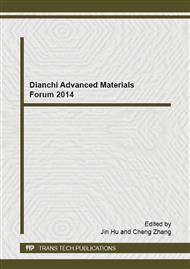p.40
p.44
p.48
p.52
p.56
p.61
p.65
p.69
p.74
The Preparation and Tribological Properties of Multi-Layer Graphene as Paraffin Liquid Additives
Abstract:
Different thickness multi-layer graphene were prepared by the method of liquid ultrasonic stripping and characterized by XRD, SEM and TEM. Friction and wear properties of graphene liquid dispersing system were investigated using an Multi-functional reciprocating friction and wear tester in ambient condition. Results indicate that the graphene were in thickness of 10nm-100nm. Multi-layer graphene showed good anti-friction and anti-wear properties as paraffin liquid additives. Multi-layer graphene liquid dispersing system had the best tribological properties with 20N and 0.01wt%, and the average friction coefficient was 0.129, and the wear mass was 4.12×106μm3, reduced by 21.34% and 41.14% than paraffin liquid. The reason is that Multi-layer graphene could adsorb on the worn surface and form solid adsorption layer, which maked the friction and wear reduce.
Info:
Periodical:
Pages:
56-60
Citation:
Online since:
November 2014
Authors:
Price:
Сopyright:
© 2014 Trans Tech Publications Ltd. All Rights Reserved
Share:
Citation:



